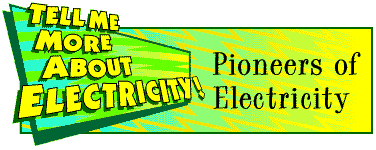 |
Alexander Graham Bell (1847-1922)
Alexander Graham Bell invented the telephone. In 1876, he spoke the first sentence over it: "Watson, come here, I want you." The telephone was exhibited at the 1876 Centennial Exposition in Philadelphia, Pennsylvania.
Thomas Alva Edison (1847-1931)
Thomas Alva Edison invented the phonograph, the motion picture camera, and more than 1,000 other things. Edison is best known for inventing the incandescent light bulb in 1879. Prior to the incandescent bulb, the world relied on oil lamps and natural gas to light the night. Edison's bulb consisted of carbonized cotton filament housed in a vacuum inside a glass bulb. The current flowing through the filament would cause it to radiate a steady glow. The vacuum was needed to keep the filament from burning up.
While still working on the light bulb, Edison began thinking about an electric system that would provide electricity from a central power station and deliver it to homes and businesses. He designed the country's first central power system, which began operating in New York City in 1882 and provided service to 85 customers. By 1902, only 20 years after the New York system began operations, there were 3,500 different electric systems in the U.S. alone. Thanks to Edison, the world was given not only the incandescent light bulb, but also efficient systems to supply electricity to people.
Michael Faraday (1791-1867)
Michael Faraday invented the generator in 1831. Before then, all useful electricity was supplied by batteries. Faraday's generator provided a source of current that did not depend on batteries.
Benjamin Franklin (1706-1790)
Contrary to popular opinion, Benjamin Franklin probably did not tie a key to a kite and fly it in a lightning storm. Franklin did, however, perform many experiments to learn more about electricity. One year Ben Franklin wanted to use electricity to kill a turkey for Christmas dinner. While checking his equipment, he touched two parts at the same time and got a big shock. His whole body vibrated, and his arms were numb until the next morning. He was lucky he wasn't burned or electrocuted! Franklin believed that lightning was a flow of electricity taking place in nature. He knew the dangers and probably did not want to risk electrical shock by flying a kite in a storm. In 1752, Benjamin Franklin's electricity experiments led him to invent the lightning rod, which when placed at the top of a barn, church steeple, or other structure, conducts lightning bolts harmlessly into the ground.
Lewis Howard Latimer (1848-1928)
Lewis Howard Latimer was a pioneer in the development of the electric light bulb. He was the son of a former slave, and was the only Black member of Thomas Edison's research team of noted scientists. While Edison invented the incandescent bulb, it was Latimer who developed and patented the process for manufacturing the carbon filaments within the bulb.
Granville Woods (1856-1910)
Granville Woods has been called "The Black Edison" for his prolific inventive skills and his ingenious contributions to mass transit. Woods patented a telephone transmitter in 1885, which was bought by Bell Telephone. He then founded the Woods Electric Company in New York City, which manufactured and sold telephone, telegraph, and electrical instruments. His most important invention was the induction telegraph system in 1887, a method of informing an engineer of trains immediately in front of and behind him, thus ensuring safer rail travel. Of the more than 60 patents that Woods registered, the majority were concerned with railroad telegraphs, electrical brakes, and electrical railway systems.
![]() Next:
Electric Vehicles
Next:
Electric Vehicles ![]()
![]() Previous:
Producing Electricity
Previous:
Producing Electricity![]()